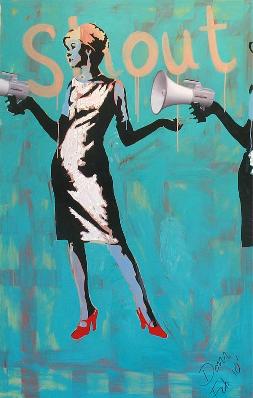What is Political Art? What Makes Art Political?

It is very difficult to define political art. Views on what makes art political can range from the idea that all art is political (i.e. it either implicitly supports or explicitly opposes the status quo) to pointing out, for example, the obviously political murals on walls around Belfast. As a way of narrowing the former and broadening the latter I suggest here a view of political art that uses three categories: Portrayal, Promotion, or Projection.
Portrayal
In the first category ‘Portrayal’ covers art that says ‘this is what happens if, is happening now or happened in the past’. This kind of art describes events or situations that people find themselves in as a result of social or political structures. Any political perspective is implicit in the art but is also free-floating. For example, a painting of a white man whipping black slaves describes a particular situation where the black man may say, ‘Yes! That is how we are treated!’ yet the slave-owner may say, ‘Yes! That is the way to treat them!’ Thus both sides can see the confirmation of their point of view in the work of art.
For the slaves, the ultimate effect of such art may be positive or negative. In a positive sense it may create group awareness and solidarity, or, in a negative sense, it could also consolidate inertia, a feeling that nothing can be done to change the situation. The art styles or movements of Realism, Social Realism and Naturalism could fit into the category of ‘
Promotion
In the second category of ‘Promotion’ ways and means towards the resolution of the problem are presented. That is, a particular aspect of an event is highlighted over other aspects. This aspect would concentrate on the people or groups who are actively struggling to change the situation in which they find themselves.
Thus one view of an event, that which would encourage others or strengthen an activism already present, is promoted over images of the event that may have the opposite effect. In this case, the politics of representation takes precedence over the representation of politics.
Unlike ‘Portrayal’, this type of art is harder to manipulate from an opposing point of view. The politics is generally explicit and can have a positive inspirational effect. The art styles or movements of Socialist Realism and ‘Political Art’ (e.g. murals, banners, posters etc.) and Social Realism to a certain extent could fit into the category of ‘Promotion’.

Eviction Scene Henry Jones Thaddeus (1889) [source History Ireland]
[In this painting above the artist represents an eviction scene from inside the house as the occupants try to deal with the fire and defend themselves from the police. The ‘politics of representation’ may be seen here in the compositional dominance given to the defenders and the very small area given over to the intruding police. The type of view we are more familiar with is of the landlord, police and passive onlookers dominating the scene from outside the house – compare eviction scene below.]

Eviction in the West of Ireland Aloysius O’Kelly (1881) [source History Ireland]
Projection
In the third and last category ‘Projection’ refers to art that takes disparate elements and then recombines them to form a new image. It is an art which says ‘This is what could happen or could be if …’. Art styles or movements such as Surrealism, collage, utopian or visionary images would fit into this category. Such speculative art can have a positive effect of providing inspiration by suggesting ideas that are outside one’s usual ways of thinking, and can be implicitly or explicitly political.
For example, a picture showing the Rock of Cashel (ancient fortress in Co. Tipperary, Ireland) with a Japanese Shinkansen bullet train speeding by may be a jarring conjunction of images but suggests the possibility of a super fast transport system in Ireland. Therefore it has social and economic implications for the Irish State which in turn makes it implicitly political.
However, like in the first category Portrayal, opposing political viewpoints can claim this image for their vision of the future. The same scene would be explicitly political though, if, for example, ‘Workers of the world unite’ was written on the side of the Shinkansen.
Thus it can be seen from the above categories that the representation of particular actions or the inclusion of particular types of text ties an image down to an explicitly political perspective. The past, present and future, with some overlapping, are also covered in this way of seeing or defining political art.
Caoimhghin Ó Croidheáin is a prominent Irish artist who has exhibited widely around Ireland. His work consists of drawings and paintings and features cityscapes of Dublin, images based on Irish history and other work with social/political themes (http://gaelart.net/). He is a Research Associate of the Centre for Research on Globalization (CRG). An earlier version of this article was published in 2010.

